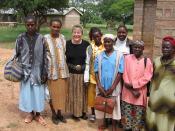BACKGROUND
Since the first AIDS cases were reported in 1981, through mid-1994 more than 402,000 AIDS cases and more than 241,000 deaths have been reported in the United States alone. This is only the tip of the iceberg of HIV infection, however. It is estimated that nearly 1 million Americans had been infected with the virus through the mid-1990s but had not yet developed clinical symptoms. In addition, although the vast majority of documented cases have occurred in the United States, AIDS cases have also been reported in almost every country in the world. Sub-Saharan Africa in particular appears to suffer a heavy burden of this illness.
No cure or vaccine now exists for AIDS. Many of those infected with HIV may not even be aware that they carry and can spread the virus. Combating it is a major challenge to biomedical scientists and health-care providers. HIV infection and AIDS represent among the most pressing public-policy and public-health problems worldwide.
COSTS
I think that the AIDS epidemic is having a profound impact on many aspects of medicine and health care. The U.S. Public Health Service estimates that in 1993, the lifetime cost of treating a person with AIDS from infection to death is approximately $119,000. Outpatient care, including medication, visits to doctors, home health aids, and long-term care, accounted for approximately 32 percent of the total cost. Persons exposed to HIV may have difficulty in obtaining adequate health-insurance coverage. Yearly AZT expenses can average approximately $6,000, although in 1989 the drug's maker did offer to distribute AZT freely to HIV-infected children. The yearly expense for DDI is somewhat less at $2,000. Therefore, if the AIDS epidemic is not controlled, its cost to American taxpayers will become overwhelming.
I feel that the effects of the epidemic on society at large...


